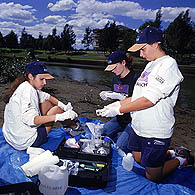
Landcare
1989
community land management movement
The landcare movement is a network of people who are committed to sustainable management and use of our natural resources. The network consists mostly of volunteers working in groups caring for soil, water, plants and wildlife affected by land degradation. The first group was formed in Victoria in 1986, but it wasn?t until 1989 that the idea became a national network.
In the early 1980s Australian governments were realising the impact that land degradation had on the Australian environment. At the same time, communities in Victoria were getting together to rehabilitate local land that had been degraded by farming or clearing. Pam Robinson and Angus Howell, leaders of a land protection group in Victoria, approached the government for support. This resulted in pilot community projects being set up around the country to encourage community involvement in improving land management.
Major political support for landcare activities came when Phillip Toyne, Director of the Australian Conservation Foundation, and Ric Farley, Director of the National Farmers Federation, made a joint approach to the Commonwealth Government for funding. Their bid was successful resulting in a major increase in funding for soil conservation and landcare. The government declared the 1990s to be the ?Decade of Landcare?.
Landcare provided information to farmers and communities and stimulated change in their attitudes towards sustainable land use. Communities came together across the country to reduce land degradation in their area. By 2000 over a third of Australia?s farmers were involved. There were over 4500 autonomous community groups in Australia and 200 Landcare groups in New Zealand. The approach was also introduced in the USA, Canada and South Africa.
Who Did It?
Key Organisations
National Soil Conservation program : funding and co-ordination 1983 -1992
National Landcare Program : funding and co-ordination 1992 - 2001
National Farmers Federation : lobbied government
Australian Conservation Foundation : lobbied government
Key People
Pam Robinson : leader of first landcare community group
Angus Howell : leader of first landcare community group
Joan Kirner : selected the name LandCare, promotion
Rick Farley : lobbied government, promotion
Phillip Toyne : lobbied government, promotion
Further Reading
Landcare: communities shaping the land and the future, Andrew Campbell, Allen and Unwin, St Leonards, 1994.
Links
National Landcare Program
Landcare Australia
National Farmers Federation
Australian Conservation
Foundation
Landcare
Australia Awards
Landcare NSW
Natural Heritage Trust
|











